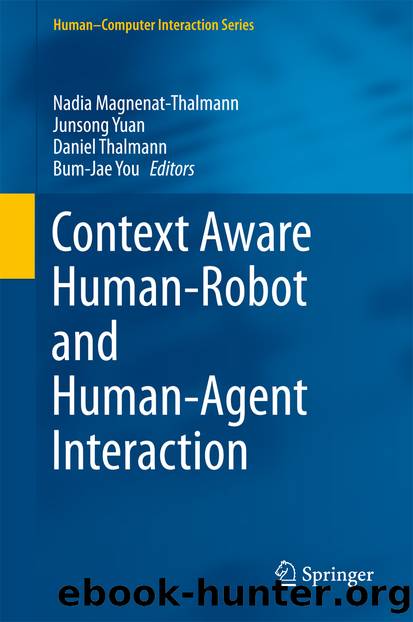Context Aware Human-Robot and Human-Agent Interaction by Nadia Magnenat-Thalmann Junsong Yuan Daniel Thalmann & Bum-Jae You

Author:Nadia Magnenat-Thalmann, Junsong Yuan, Daniel Thalmann & Bum-Jae You
Language: eng
Format: epub
Publisher: Springer International Publishing, Cham
7.3.2 Selection of Motion Primitives
The motion-primitive selection mechanism of a robot has been studied using various approaches. Smith et al. [19] and Kunniawati et al. [20] proposed methods for decision making in approximate partially observable Markov decision processes (POMDPs). POMDPs constitute a powerful probabilistic method for modeling dynamic and stochastic sequences of events in the limited perceptions of a virtual human. However, the computation of exact optimal policies in the animation is intractable as this process has extensive computational complexity. To improve the computational efficiency, Smith et al. proposed a POMDP-based planning algorithm referred to as heuristic search value iteration (HSVI). Similarly, Kuniawati et al. proposed an algorithm referred to as successive approximations of the reachable space under optimal policies (SARSOP) that can select dependable motion primitives under various uncertainties. However, these algorithms cannot be used to generate various motion-primitive sequences that have never been previously experienced, or are âunexperiencedâ because the dependable motion primitive is selected using a probabilistic method.
Lebeltel et al. [21] and Dearden et al. [22] presented methods for modeling a task using probabilistic approaches. Lebeltel et al. proposed a method for programming a robot based on Bayesian inference and learning with respect to incompleteness and uncertainty. They used predefined transition probabilities to manage temporal motion-primitive sequences. It is a challenge to predefine transition probabilities to solve all motion-primitive sequences. Dearden et al. proposed a method for using a Bayesian network as a learning technique to manage task execution in mobile robotics. Their research indicated that Bayesian networks are valuable learning mechanisms capable of dealing with uncertainty and variation.
Calinon et al. [4] and Lee et al. [23] presented methods for realizing a task by encoding probabilistic models. Calinon et al. encoded and generalized probabilistic models using Gaussian/Bernoulli mixture models and Gaussian mixture regression. Lee et al. encoded the probabilistic models using HMMs and reproduced a trajectory using a Viterbi algorithm. They focused on encoding probabilistic models of entire tasks and reproducing trajectories using demonstrated trajectories, i.e., they considered the reproduction of trajectories using encoded models and not the various motion-primitive sequences that can occur in a real environment. These probabilistic methods can be usefully applied under various uncertainties, especially limited perception, because they compute probabilities of motion primitives using a Bayesian inference algorithm. Although they can successfully achieve complete tasks based on experienced motion-primitive sequences, they have difficulty of achieving tasks in situations that require unexperienced motion-primitive sequences.
Pardowitz et al. [24] and Ekvall and Kragic [25] proposed hierarchical and incremental approaches for modeling a task based on many demonstrations. Pardowitz et al. hierarchically encoded motion primitives based on macro-operators and a task precedence graph. Ekvall and Kragic extracted and updated symbolic rules using demonstrations and achieved given tasks based on symbol-level methods. Although they dealt with motion primitive sequences of complex tasks, they were required to generate nodes of graphs or symbolic rules continually, whenever unexperienced motion-primitive sequences were necessary.Table 7.2Qualitative comparison for related works from viewpoint selecting motion primitives
Download
This site does not store any files on its server. We only index and link to content provided by other sites. Please contact the content providers to delete copyright contents if any and email us, we'll remove relevant links or contents immediately.
Algorithms of the Intelligent Web by Haralambos Marmanis;Dmitry Babenko(8522)
Test-Driven Development with Java by Alan Mellor(7389)
Data Augmentation with Python by Duc Haba(7290)
Principles of Data Fabric by Sonia Mezzetta(7037)
Learn Blender Simulations the Right Way by Stephen Pearson(6972)
Microservices with Spring Boot 3 and Spring Cloud by Magnus Larsson(6797)
RPA Solution Architect's Handbook by Sachin Sahgal(6206)
Hadoop in Practice by Alex Holmes(6030)
The Infinite Retina by Robert Scoble Irena Cronin(5905)
Jquery UI in Action : Master the concepts Of Jquery UI: A Step By Step Approach by ANMOL GOYAL(5873)
Big Data Analysis with Python by Ivan Marin(5715)
Life 3.0: Being Human in the Age of Artificial Intelligence by Tegmark Max(5402)
Pretrain Vision and Large Language Models in Python by Emily Webber(4676)
Infrastructure as Code for Beginners by Russ McKendrick(4458)
WordPress Plugin Development Cookbook by Yannick Lefebvre(4189)
Functional Programming in JavaScript by Mantyla Dan(4124)
The Age of Surveillance Capitalism by Shoshana Zuboff(4115)
Embracing Microservices Design by Ovais Mehboob Ahmed Khan Nabil Siddiqui and Timothy Oleson(3975)
Applied Machine Learning for Healthcare and Life Sciences Using AWS by Ujjwal Ratan(3953)
